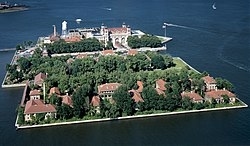
Ellis Island
Ellis Island is a federally owned island in New York Harbor, situated within the U.S. states of New Jersey and New York, that was the busiest immigrant inspection and processing station in the United States. From 1892 to 1954, nearly 12 million immigrants arriving at the Port of New York and New Jersey were processed there under federal law. Today, it is part of the Statue of Liberty National Monument and is accessible to the public only by ferry. The north side of the island is the site of the main building, now a national museum of immigration. The south side of the island, including the Ellis Island Immigrant Hospital, is open to the public only through guided tours.
In the 19th century, Ellis Island was the site of Fort Gibson and later became a naval magazine. The first inspection station opened in 1892 and was destroyed by fire in 1897. The second station opened in 1900 and housed facilities for medical quarantines and processing immigrants. After 1924, Ellis Island was used primarily as a detention center for migrants. During both World War I and World War II, its facilities were also used by the US military to detain prisoners of war. After the immigration station’s closure, the buildings languished for several years until they were partially reopened in 1976. The main building and adjacent structures were completely renovated in 1990.
The 27.5-acre (11.1 ha) island was greatly expanded by land reclamation between the late 1890s and the 1930s. Jurisdictional disputes between New Jersey and New York State persisted until the 1998 US Supreme Court ruling in New Jersey v. New York.
Lists containing Ellis Island :
List of 38 Heritage Sites in America

The United States is home to a vast array of cultural and natural heritage sites that are of great significance to the country’s history, identity, and landscape. These heritage sites are recognized for their outstanding universal value and are protected by federal and state laws to ensure their preservation for future generations. The list of…
